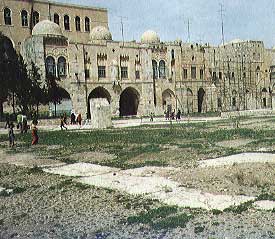

may the Moshiach come right now and we will be able to enter the third beis hamikdosh


 Northern Wall Area. All of these buildings are also built over the Northern Wall.
Northern Wall Area. All of these buildings are also built over the Northern Wall. School Building. This school is built over the Northern Wall. In years past, it was used as an army barracks for Turkish soldiers.
School Building. This school is built over the Northern Wall. In years past, it was used as an army barracks for Turkish soldiers.
 More than Meets the Eye. Only a small portion of Barclay's gate is seen today. Most of it is hidden by the Moslem wall and is buried below ground. The original gateway was about 30 feet high (3 stories) and 15 feet wide.
More than Meets the Eye. Only a small portion of Barclay's gate is seen today. Most of it is hidden by the Moslem wall and is buried below ground. The original gateway was about 30 feet high (3 stories) and 15 feet wide. The Great Lintel Stone. The lintel stone on Barclay's Gate in 27 feet long and weighs over 100 tons!
The Great Lintel Stone. The lintel stone on Barclay's Gate in 27 feet long and weighs over 100 tons! Barclay's Blocked Gate. In the center of the photo is part of the great lintel stone that rested atop Barclay's Gate. The rest of the stone is blocked by the wall the Arabs built years ago. Atop the steps is a small room which women now use for prayers. More of the stone can be seen from inside that room. The small stones, behind the railing on the steps, were placed there by the Arabs to block the opening of Barclay's Gate.
Barclay's Blocked Gate. In the center of the photo is part of the great lintel stone that rested atop Barclay's Gate. The rest of the stone is blocked by the wall the Arabs built years ago. Atop the steps is a small room which women now use for prayers. More of the stone can be seen from inside that room. The small stones, behind the railing on the steps, were placed there by the Arabs to block the opening of Barclay's Gate.
 "No Gentiles Allowed" Fragment. This is fragment from another stone. It too is written in Greek. This one can be seen in the Israel Museum in Jerusalem.
"No Gentiles Allowed" Fragment. This is fragment from another stone. It too is written in Greek. This one can be seen in the Israel Museum in Jerusalem.

 Ashlar Fragment. Building stones that were used within the "azarah," had to be perfectly smooth. The surface of this jagged stone is very smooth.
Ashlar Fragment. Building stones that were used within the "azarah," had to be perfectly smooth. The surface of this jagged stone is very smooth. Ashlar Fragment. This building stone was part of a building outside the "azarah." Notice the rough design carved onto the surface of the fragment. This stone was discovered by the "museum" curator's wife during an expedition in 1982
Ashlar Fragment. This building stone was part of a building outside the "azarah." Notice the rough design carved onto the surface of the fragment. This stone was discovered by the "museum" curator's wife during an expedition in 1982 Floor Tile Fragment. The floor of the "azarah" consisted of white tiles, tan tiles, and bluish-purple tiles. This interesting stone was discovered by the "museum" curator's son, Menachem.
Floor Tile Fragment. The floor of the "azarah" consisted of white tiles, tan tiles, and bluish-purple tiles. This interesting stone was discovered by the "museum" curator's son, Menachem.








